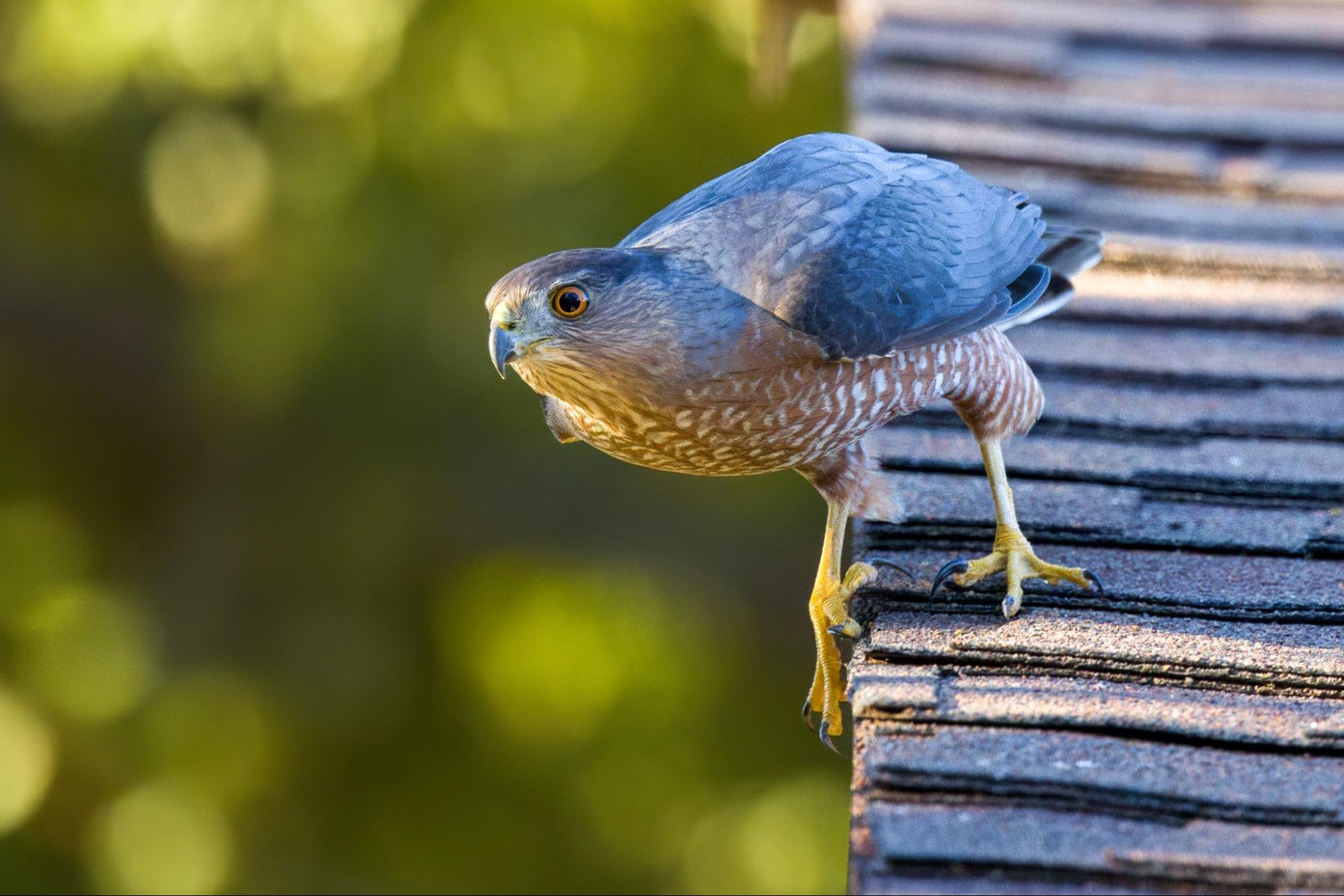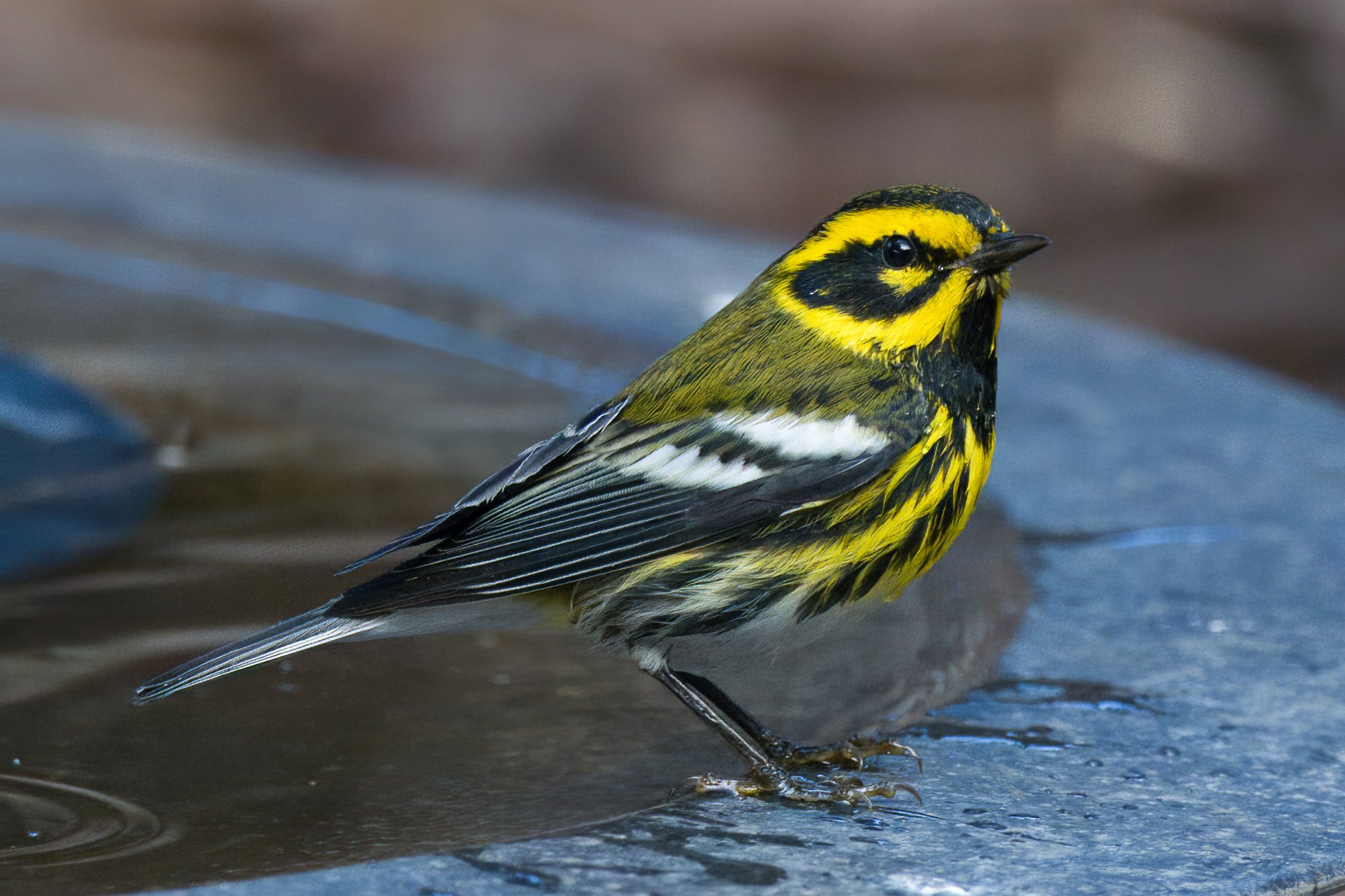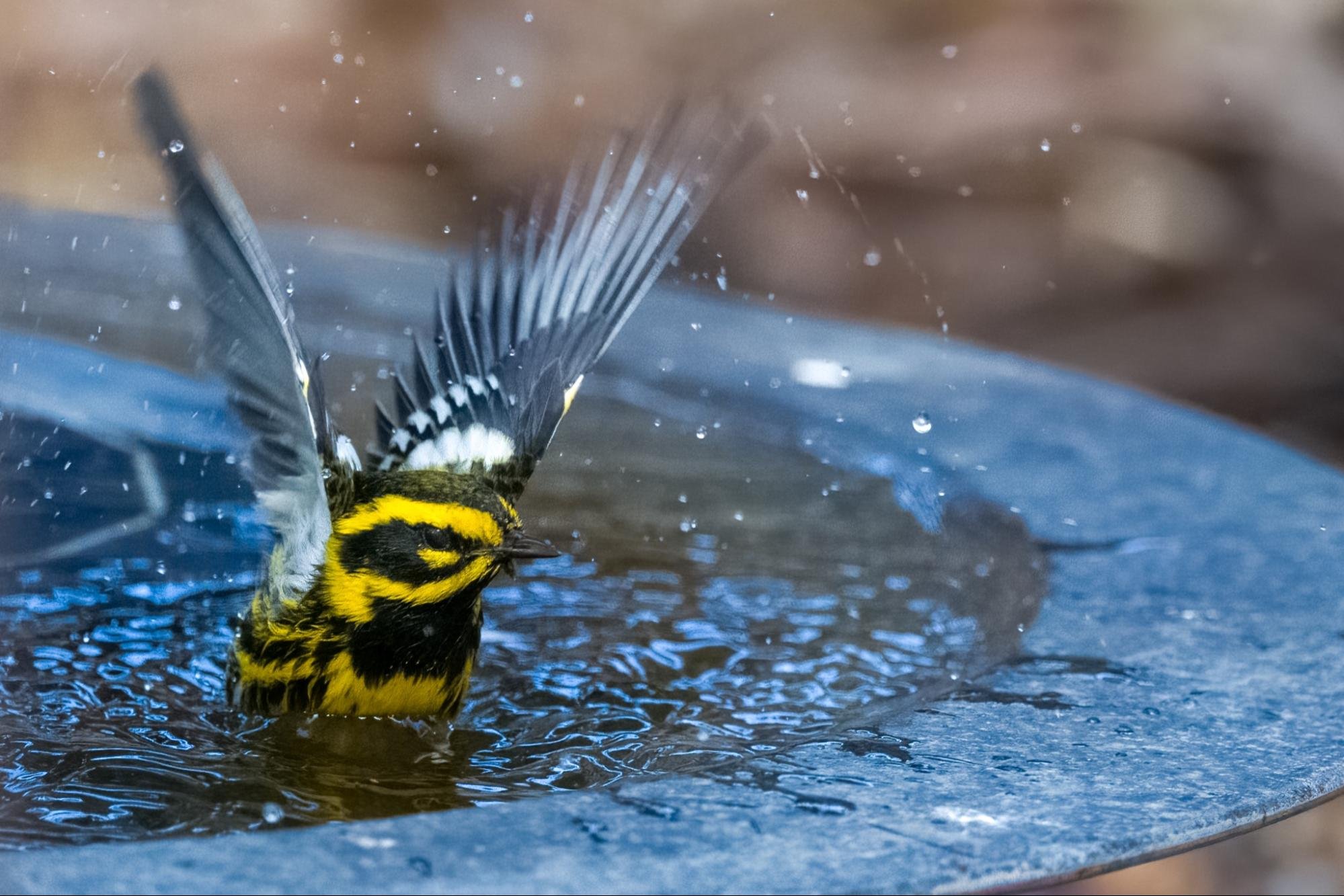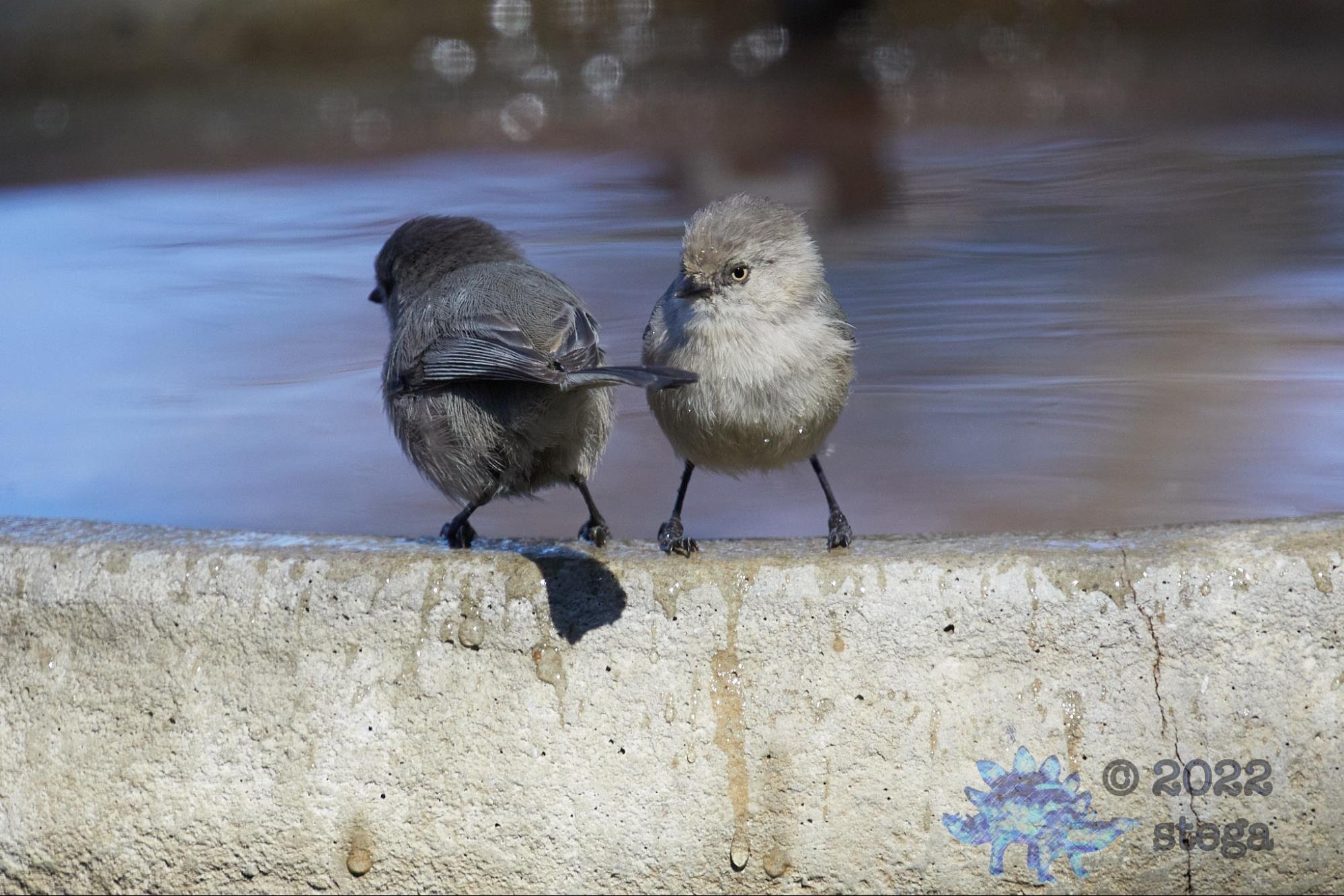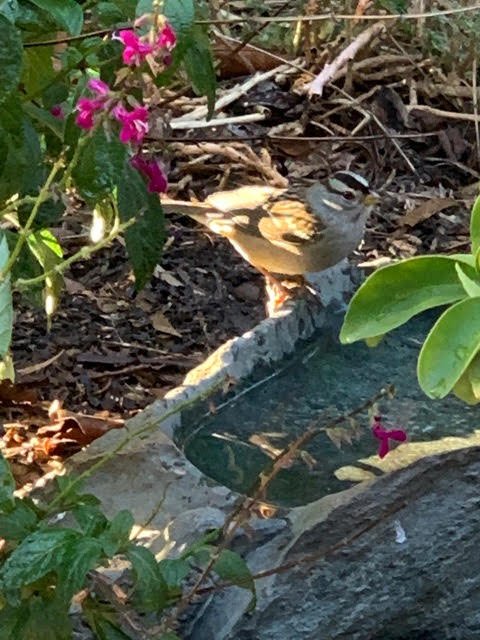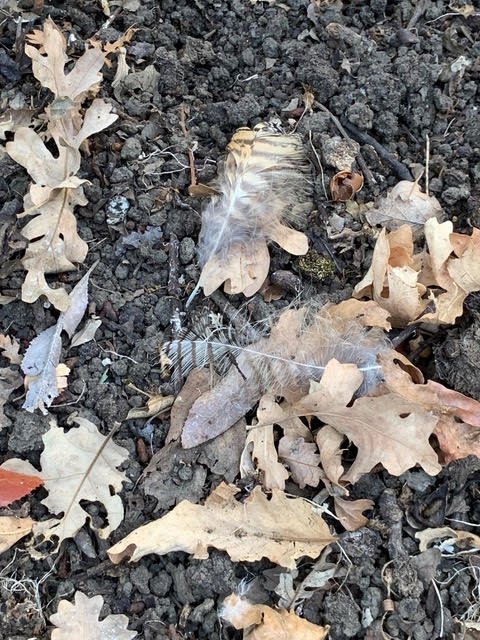BACKYARD BIRD OBSERVATIONS
FROM OUR MEMBERS AND FRIENDS
October was a splendid fall month. For backyard birders, the transition to winter continued during this time, and many of you noticed birds that spend the colder months in the Bay Area.
Yellow-rumped and Townsend’s Warblers, our two winter resident warblers, are here for the season, and you enjoyed observing their beautiful, sunny patches of color and listening to their calls. (See the photos and ID tips below for more about these two birds.) Not to be outdone by the warblers, Hermit Thrushes were popping up in more places, and White-crowned and Golden-crowned Sparrows were seemingly everywhere.
Some of you shared behavioral observations that intrigued you: a Cooper’s Hawk that dominated a backyard for the better part of a month, an American Kestrel that appeared right after the installation of a new nest box, and a Downy Woodpecker that diligently excavated a roost cavity for over a week.
This month, All Around Town received its first audio submittals! Enjoy the sounds of a duetting pair of Great Horned Owls, a group of Red-winged Blackbirds, and a House Finch with a whole lot to say (listen below).
We added one new species to All Around Town’s collective bird list in October: the Red-winged Blackbird (observed in San Jose). While not an uncommon bird, the Red-winged is usually found either close to water or in agricultural areas, making it an unusual backyard bird for many of us. Males are distinctive because of their red “epaulets,” bright bursts of color on each shoulder (in our area, the birds lack the yellow border on the shoulder patch that is typical elsewhere). Females look different from the males - they are brown and streaky. You can hear the Red-winged Blackbird’s iconic bubbly trill echoing through wetlands in the springtime.
Here are your backyard and neighborhood bird observations for the month of October:
A female Nuttall’s Woodpecker visits Curt’s home. Note the horizontal barring across her back, which distinguishes the Nuttall’s Woodpecker from other woodpecker species in our area.
Curt Bianchi (Saratoga) writes: “Here in my neighborhood I have seen three woodpeckers: Nuttall’s, Downy, and Acorn Woodpeckers. The Nuttall’s are regular visitors to our two suet feeders, and were voracious eaters during nesting season. This month I heard the chirping of a Nuttall’s in the backyard. It repeatedly vocalized single chirps, which I thought was unusual. Eventually I went outside and found it hanging on a maple tree near our backyard suet feeder. It stayed there long enough for me to go back inside, get my camera, come back, and snap some photos. Eventually it flew to the feeder and had a snack.”
He continues: “I have frequently heard the hooting of Great Horned Owls from inside our home, both in the evening and before dawn. It’s always great to hear them here in suburbia. Sometimes they are quite close and I have tried recording them. Here are two Great Horned Owls, as captured on my portable audio recorder on my front porch, and processed to reduce the background noise.”
John K. Edwards (Sunnyvale) says: “Our backyard was moderately quiet this month - primarily because a Cooper's Hawk decided to pay it lots of attention. We first noticed the bird in September, but it dominated the backyard in October. Because of this, many of the other birds have been much more reluctant to hang out.”
An adult Cooper’s Hawk poised for takeoff in John’s backyard. Did it have its eye on prey? Note the gray feathers on its back and wings.
An adult Cooper’s Hawk in John’s yard, photographed in September. Many identifying features can be seen in this picture - the bird’s dark cap, red eye, heavy reddish-orange barring on the breast and part of the belly, and gray-and-black striped tail feathers, tipped with white.
He adds: “One day in late October we did get a surprise visit to the bath from a Townsend's Warbler, which frolicked for a bit.”
A Townsend’s Warbler visits John’s bird bath. The Townsend’s sports a dark cheek patch and eyeline on a bright lemony head. It has a yellow and black breast, a white belly, streaked sides, and black and white wings. The Townsend’s and the Yellow-rumped Warbler (see photos further below) are our two winter resident warblers.
The Townsend’s Warbler observed by John, enjoying a bath
Eve Meier (San Jose) wrote on October 15: “I have a beautiful Townsend’s Warbler in my yard. I could hear its ‘chip’ call while doing yard work and eventually found it in our cedar tree.”
A Yellow-rumped Warbler at LC’s bird bath. The Yellow-rumped is our most abundant winter warbler. It is a gray and white bird with bright buttery-yellow splashes of color on its throat, rump, and sides. It makes a sharp "chep!" call, which it may repeat periodically. You will often hear these birds before you see them.
LC Boros (San Jose) says: “Cooler evenings and the arrival of the Golden-crowned and White-crowned Sparrows haven’t made a dent in the activity here, as we’re awash in sparrows and finches (House Finches and Lesser Goldfinches) plus the usual herds of roving California Quail.”
Bushtits at LC’s bird bath
“A merry band of Bushtits descended on the garden areas for a brief stint, and when they flitted off Frank the Yellow-rumped Warbler started hanging out. It is quite shy and prefers the company of the Chestnut-backed Chickadees and White-breasted Nuthatches at the baths.”
A Northern Mockingbird enjoys LC’s bird bath!
A Spotted Towhee in LC’s yard
“Frank the Spotted Towhee is now in residence. It is much less shy and will happily share the ground, feeders, and baths with any other bird. While the Acorn Woodpeckers cackle, our jays continue to share somewhat nicely the nut offerings, but the three Steller’s Jays have grown into fine birds and are now significantly larger than this year’s fledged California Scrub-Jays. The resident California Thrashers and Northern Mockingbirds seem to think the jays are all very silly since there’s plenty of suet, seeds, nuts, and mealworms to go around, while the coddled hummingbirds seem perturbed that all of the oriole feeders have been swapped for smaller nectar feeders sans perches.”
A nest box newly installed by LC
“The biggest new thing here at the ranch is that several nest boxes were installed at the end of the month. With the excavator I piloted holes for six-foot lengths of steel pipe which I sank halfway down and secured with concrete. Twelve-foot poles of larger diameter then slip over the stubs to allow the new boxes to be well off the ground — Flicker, Kestrel, Owl and Bat. (Shout out to Amador Barn Owl Box Company for advice on the method!)”
A male American Kestrel surveys the scene at LC’s home. Male kestrels have blue-gray wings and extensive blue-gray color on the head. Females have less blue color on the head, and rusty-red wings with black barring, without any blue in them.
LC continues: “My extra ‘hack’ was to drill through both pipes and run hitch pins through the holes to keep the boxes from being rotated by our heavy winds. Just one day after installing the kestrel box out near the eastern fence line, an American Kestrel appeared atop the old mast pole at the edge of the house yard. Normally, Frank the Red-Tailed Hawk, who is looking quite well-fed and recovered from this year’s breeding, uses that spot to watch for tasty-tasty things, so to see Frank the Kestrel in the hawk’s usual spot was delightful.”
Kristin Lynn (San Jose) enjoyed listening to bird sounds over the past month, including hummingbirds, Killdeer, and Red-winged Blackbirds.
Kristin has been noticing Red-winged Blackbirds around her home for a while, even before she knew what species they were. She writes: “Fast forward to October, when I was hearing some of these birds making a racket in the bushes and trees in the nearby park. I can hear them from my home, but when I've been out I haven't gotten a good look at them (I usually had my hands full of groceries). One day they were flying around near my window and were up on the roof. I wasn’t able to get a good look, but they were really loud.” Kristin recorded the birds - listen to a clip from her recording above.
She also recorded “a particularly long-winded male House Finch” in October. She says, “I love the complexity of the sounds - one can only imagine what he’s saying (and to whom).”
Kristin’s composite of this Yellow-rumped Warbler shows the bird’s buttery-yellow patches on its throat, sides, and rump.
Kristin observed this Yellow-rumped Warbler, “who was only here for less than a minute, I think, but seemed to want to show off every angle! I haven't seen the warbler since, and I don't remember if I heard it, but I think I must have if I looked up and saw it. I'm so familiar with the sounds of the hummingbirds, House Finches, and Lesser Goldfinches, who are here all the time now, so if I hear anyone else it makes me look (even my beloved Dark-eyed Juncos, who only come by a couple of times a day).”
Emma Shelton (Menlo Park) writes: “October was actually pretty busy. We still have lots of Oak Titmice, Lesser Goldfinches, Chestnut-backed Chickadees, House Finches, Dark-eyed Juncos, White-breasted and Pygmy Nuthatches, Spotted Towhees, and Mourning Doves, some noisier than others and some just staying busy without making much racket.”
A White-crowned Sparrow perches on the side of Emma’s bird bath.
“Our White-crowned and Golden-crowned Sparrows have been back for a bit over a month now, and are multiplying and enjoying the yard. Every time I watch the White-crowns checking out the bird bath they are extremely hesitant, then hop in as if afraid of getting wet. California Towhees, however, just dive right in and splash around!”
Feathers from a Great Horned Owl, observed by Emma. The U.S. Fish & Wildlife Service’s Feather Atlas is a good identification resource. Please be aware that it is against the law to possess the feathers of most birds without a permit. You may study and photograph feathers in nature, but you must leave them where you found them.
Emma continues: “A friend’s house in Atherton has a little wild area in the backyard with lots of various oak trees, including valley oaks. I always hear Red-shouldered Hawks when I am there, and I know that Great Horned Owls are there at night. Feathers in photo. What is really amazing is that there are SO MANY Raptor Pellets! Also Red-shouldered Hawk feathers seen.”
A likely raptor pellet, observed by Emma. While mammalian predators chew and break bones, clumps of intact bones are typical of avian predators.
Here is Emma’s yard and neighborhood list for October:
Canada Goose
Rock Pigeon
Mourning Dove
Anna’s Hummingbird - I don’t have feeders for them but the plants in the yard seem to draw them in. In the yards I am in between Menlo Park and Woodside there are many, attracted by all sorts of salvias and California fuchsias, plus other tubular or red flowers.
Gull species
Turkey Vulture
Cooper’s Hawk
Western Screech-Owl - heard one in late evening on October 4
Downy Woodpecker - one showed up mid-October at the feeder
Nuttall’s Woodpecker
California Scrub-Jay
American Crow
Chestnut-backed Chickadee
Oak Titmouse
Ruby-crowned Kinglet - I haven’t actually seen one this fall, but the Merlin app told me it heard one at our house and at a friend’s house in Atherton.
White-breasted Nuthatch
Pygmy Nuthatch
Bewick’s Wren
Western Bluebird - I was surprised to see several at a nearby neighborhood park!
Hermit Thrush - This has been the big bird of the month. I don’t recall seeing so many and in so many places. At our house and everywhere between here, Atherton, and Woodside.
American Robin - I had not seen any at our house for years, but I did for sure last week!
House Finch
Lesser Goldfinch
Dark-eyed Junco - the most ubiquitous bird ever
White-crowned Sparrow
Golden-crowned Sparrow
California Towhee
Spotted Towhee
A Western Bluebird, likely female, in muted winter colors, observed by Emma
Jack Cole (San Jose) had five Western Bluebirds in his bird bath on October 7, a record for his yard. On November 5, he reported that the bluebirds were still around, and that he had both a male and female bird at his bath as he wrote. Jack heard his first White-crowned Sparrow of the winter season on October 7.
On October 11, Linden Skjeie (San Jose) wrote: “There was a pair of California Thrashers in a yard the other morning. I don’t usually see them in the neighborhood.” She also saw a Western Bluebird perched on a sign.
A Downy Woodpecker excavates a roost cavity at Mary Ann’s home.
Mary Ann Robertson (Los Altos) tells us: “A Downy Woodpecker is making a hole in the dead part of my backyard locust tree. The hole is probably for a winter roost. I photographed her working between October 12 and 20. (On October 29, I spotted a Nuttall's Woodpecker checking out the hole so if the Downy doesn't use it, maybe the Nuttall's will.)”
Downy and Hairy Woodpeckers look very similar, but one of the ways you can tell them apart is by the black spots usually present on the Downy’s white outer tail feathers. The Hairy’s white tail feathers are usually unmarked.
Happy backyard birding in November, everyone!
What birds are you seeing and hearing in your yard and neighborhood?
Send your stories, lists, photos, sketches, videos, and audio recordings to backyardbirds@scvas.org. We’ll feature them in our next edition of All Around Town.
Bird species reported to All Around Town
from October 2020 onwards
(species in bold are new this month)
Greater White-fronted Goose
Canada Goose
Mallard
Bufflehead
California Quail
Wild Turkey
Indian Peafowl (feral)
Rock Pigeon
Band-tailed Pigeon
Eurasian Collared-Dove
Mourning Dove
Vaux’s Swift
White-throated Swift
Anna’s Hummingbird
Rufous Hummingbird
Allen’s Hummingbird
Killdeer
California Gull
Double-crested Cormorant
Great Blue Heron
Great Egret
Snowy Egret
Black-crowned Night-Heron
Turkey Vulture
White-tailed Kite
Golden Eagle
Northern Harrier
Sharp-shinned Hawk
Cooper’s Hawk
Bald Eagle
Red-shouldered Hawk
Red-tailed Hawk
Ferruginous Hawk
Barn Owl
Western Screech-Owl
Great Horned Owl
Red-breasted Sapsucker
Acorn Woodpecker
Downy Woodpecker
Nuttall’s Woodpecker
Hairy Woodpecker
Pileated Woodpecker
Northern Flicker
American Kestrel
Merlin
Olive-sided Flycatcher
Western Wood-Pewee
Pacific-slope Flycatcher
Black Phoebe
Say’s Phoebe
Western Kingbird
Hutton’s Vireo
Cassin’s Vireo
Warbling Vireo
Steller’s Jay
California Scrub-Jay
Yellow-billed Magpie
American Crow
Common Raven
Chestnut-backed Chickadee
Oak Titmouse
Northern Rough-winged Swallow
Tree Swallow
Violet-green Swallow
Barn Swallow
Bushtit
Wrentit
Ruby-crowned Kinglet
Red-breasted Nuthatch
White-breasted Nuthatch
Pygmy Nuthatch
Brown Creeper
House Wren
Bewick’s Wren
European Starling
California Thrasher
Northern Mockingbird
Western Bluebird
Varied Thrush
Hermit Thrush
American Robin
Cedar Waxwing
Scaly-breasted Munia
House Sparrow
House Finch
Purple Finch
Pine Siskin
Lesser Goldfinch
Lawrence’s Goldfinch
American Goldfinch
Chipping Sparrow
Dark-eyed Junco
White-crowned Sparrow
Golden-crowned Sparrow
White-throated Sparrow
Savannah Sparrow
Lincoln’s Sparrow
California Towhee
Spotted Towhee
Western Meadowlark
Hooded Oriole
Bullock’s Oriole
Red-winged Blackbird
Brown-headed Cowbird
Orange-crowned Warbler
Yellow Warbler
Yellow-rumped Warbler
Townsend’s Warbler
Canada Warbler
Wilson’s Warbler
Western Tanager
Black-headed Grosbeak
Lazuli Bunting
Hybrid ducks, domestic ducks, unidentified gull species, and Rufous/Allen’s Hummingbirds have also been reported to All Around Town.
All Around Town is compiled by SCVAS Member Julie Amato.
Banner Photo: Townsend’s Warbler by John K. Edwards



